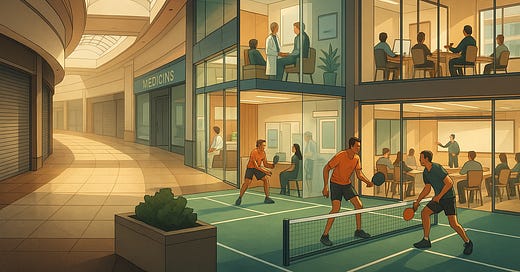INTRODUCTION
Once the beating heart of suburban life, America’s shopping malls now stand at a crossroads. Their skylights and marble floors, once thronged with Saturday shoppers and teenagers lingering by fountain courts, echo with awkward silence. Major department stores have boarded up entryways, food courts sit empty of families, and escalators groan with unused machinery. Despite these signs of decline, a different narrative is unfolding—one of adaptation and rebirth.
Across the country, developers and community leaders are reimagining these vast structures. Some malls are evolving into medical centers offering primary care, urgent care, and specialty clinics. Others host satellite university campuses, delivering degree programs to nontraditional students. In certain regions, faith groups and civic organizations have claimed abandoned wings for community gatherings. Meanwhile, entrepreneurs are transforming dead storefronts into pop-up markets, indoor farms, and entertainment venues.
This wave of reinvention isn’t merely a practical response to empty retail space. It reflects shifting cultural values about place and purpose. Malls were once designed for consumption—spaces optimized for retail flows and impulse purchases. Now their wide corridors, abundant parking, and existing infrastructure make them ideal for functions that serve broader social needs. In watching these transformations, we see how communities negotiate the legacy of consumer culture and forge new paths forward. The afterlife of the American mall is not a static monument to failure but an active experiment in repurposing.
A BRIEF HISTORY OF THE MALL BOOM—AND BUST
The enclosed shopping mall emerged in the early 1950s as a novel concept: an indoor public square that combined retail, dining, and leisure under a single roof. Victor Gruen, an Austrian architect, envisioned these spaces as 20th-century town centers, complete with benches, planters, and fountains. By the 1970s and 1980s, the model proliferated. Developers raced to build regional malls on cheap suburban land, anchoring them with department stores like Sears, JCPenney, and Macy’s.
For decades, foot traffic sustained a thriving ecosystem. Specialty retailers—including The Gap, Foot Locker, and Bath & Body Works—flocked to mall corridors. Food courts offered cheap, curated menus. Movie theaters, arcades, and play areas augmented the shopping experience. Teenagers claimed the space as a social hub, while families treated mall visits as weekend rituals. At their peak in the late 1990s, roughly 2,500 major malls operated nationwide.
The 21st century brought a series of shocks. The rise of e-commerce allowed consumers to shop from home. The 2008 financial crisis eroded middle-class spending power. More recently, the COVID-19 pandemic accelerated store closures and remote work, shrinking demand for retail real estate. By 2020, mall vacancy rates climbed to nearly 11 percent, the highest level in decades. Some iconic centers—like Dixie Square Mall in Illinois, shuttered in 1978 and left to decay—became symbols of retail’s failure.
Yet these empty halls and boarded-up windows also presented an opportunity. Rather than razing every unused property, many communities began exploring how to adapt existing structures to new needs. Mall bones—wide corridors, high ceilings, and sturdy foundations—offered a foundation for creative reuse.
FROM SHOPS TO SERVICES: A NEW MALL AGENDA
1. Healthcare Centers
Converting malls into healthcare hubs has become one of the most visible trends. In Burlington, Vermont, part of University Mall now houses a state-run COVID testing and vaccination site. Its success prompted health officials to consider permanent clinics in that location, offering primary care, diagnostics, and telehealth booths. In Alexandria, Virginia, the Landmark Mall is undergoing a $1 billion transformation into an Inova Health System medical campus. The plan includes urgent care facilities, imaging centers, outpatient surgery suites, and medical office space. Mall layouts—with wide corridors and multiple entrances—allow discrete patient flows, separating general visitors from those seeking clinical services.
2. Education Hubs
Higher education institutions are also eyeing malls for expansion. Satellite campuses benefit from the parking capacity and transit access inherent to these sites. Chattanooga State Community College opened classrooms and labs in Northgate Mall, offering evening and weekend courses to working adults. In Lubbock, Texas Tech University repurposed part of South Plains Mall for professional development and continuing education programs. These initiatives reduce overhead compared to constructing new buildings, and they place campuses directly within the communities they serve.
3. Religious and Community Space
Communities have claimed empty department stores for worship and gatherings. At Potomac Mills Mall in Woodbridge, Virginia, a large faith organization now meets in a remodeled anchor space, seating thousands and offering youth programs. Meanwhile, some local governments lease mall wings for community centers, food banks, and nonprofit offices. These adaptations leverage existing infrastructure—parking, HVAC, restroom facilities—while providing affordable, accessible locations for vital services.
CULTURE SPACES AND NICHE COMMERCE
4. The Return of Entertainment Anchors
With traditional retail in decline, experience-based tenants are becoming new anchors. American Dream Mall in East Rutherford, New Jersey, emphasizes skiing, water parks, and themed attractions over clothing stores. In Missoula, Montana, Southgate Mall turned its old Sears into a 16-lane bowling alley and indoor golf simulator. Eau Claire, Wisconsin’s Oakwood Mall now hosts an escape room, trampoline park, and a curated artisan food court. These venues draw visitors not to buy goods but to engage in activities, extending dwell time and generating new revenue streams.
5. Micro-Retail and Pop-Ups
Smaller entrepreneurs find opportunities in low-rent storefronts. Vacant mall spaces have become testing grounds for local makers, seasonal markets, and pop-up boutiques. In suburban Chicago, artisanal bakers lease former kiosk areas to sell fresh bread and pastries. In Phoenix, a collective of independent jewelry designers shares a cluster of booths in a defunct wing, offering rotating product lines. This micro-retail model creates a more diverse shopping environment, with a mix of handcrafted goods, specialty foods, and limited-time events that appeal to local customers.
WHEN MALLS BECOME HOUSING
Perhaps the boldest reinventions involve converting malls into residences. Highland Mall in Austin, Texas, was reborn as the Austin Community College Eastview campus, intertwined with public housing and government offices. The site features student apartments, community gardens, and shared study spaces. Near Cincinnati, the Eastgate Mall project is transforming a third of its square footage into multi-family housing. Developers are building apartment units surrounded by walkable green spaces and retail pods—reversing the car-centric layout of traditional malls.
These mixed-use developments address two pressing needs: surplus commercial real estate and affordable housing shortages. Developers benefit from existing structures—large floor plates and parking garages—while municipalities gain new housing stock without greenfield development. Projects must navigate zoning changes, retrofit utilities, and ensure residential privacy within former retail zones. Architects add new entrances, reconfigure HVAC systems for individual units, and carve out communal areas. The result can be a vibrant neighborhood hub, where residents live, shop, and work in close proximity.
WHAT WE’RE REALLY TALKING ABOUT
On the surface, mall conversions are real estate deals driven by market forces. Vacancy rates hit record highs, and landlords face mounting carrying costs. Filling empty space with clinics, classrooms, or housing is a way to stabilize income. Yet the trend signals a deeper shift in how Americans use built environments.
Malls were once designed to maximize impulse spending. Wide corridors channeled shoppers past storefronts. Uniform lighting and controlled climates created comfort that kept people inside. Repurposing these spaces forces us to reconsider our relationship with them. When a mall hosts a community health fair, people return to a place once dedicated to commerce. When classrooms occupy former food courts, the mall becomes a node of learning rather than consumption. Each new use rewrites the social contract embedded in the architecture.
THE PSYCHOLOGY OF RECLAMATION
There’s a powerful emotional element to reclaiming abandoned malls. For many adults, malls evoke memories of adolescent rites of passage: first jobs at the local department store, weekend movies, and the ritual of mall walking. Seeing these structures revived for community purposes taps into nostalgia. It feels like reclaiming shared spaces rather than surrendering them to parking lots or demolition crews.
Community members often express relief that familiar landmarks won’t vanish entirely. Instead, they undergo a second life, accommodating new routines. Local stakeholders—planners, nonprofits, residents—take ownership of these transformations, advocating for uses that address pressing needs: healthcare access, education, housing. The sense of collective achievement strengthens civic bonds. In effect, the mall’s identity shifts from a private commercial venture to a semi-public commons.
FINAL THOUGHTS
There’s no single destiny for America’s malls. Some will remain hollow reminders of retail’s heyday, others will vanish under the wrecking ball. Yet those that endure often do so by embracing change and serving community needs. Their sprawling footprints, once designed for shopping sprees, now accommodate healing, learning, living, and play.
In a culture obsessed with the new, repurposing malls represents a quieter revolution: using what we already have to meet evolving needs. It’s not just about saving buildings—it’s about saving connections. As these once-busy centers reinvent themselves, they offer a blueprint for adaptive reuse across all kinds of structures. If the mall afterlife teaches us anything, it’s that place and purpose can evolve together, shaping community life for generations to come.
Thank you for your time today. Until next time, stay safe.
Do you like what you read but aren’t yet ready or able to get a paid subscription? Then consider a one-time tip at:
https://www.venmo.com/u/TheCogitatingCeviche
Ko-fi.com/thecogitatingceviche
















Share this post